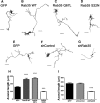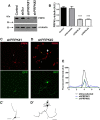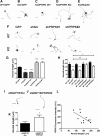Rab35 Functions in Axon Elongation Are Regulated by P53-Related Protein Kinase in a Mechanism That Involves Rab35 Protein Degradation and the Microtubule-Associated Protein 1B
- PMID: 27383602
- PMCID: PMC6705529
- DOI: 10.1523/JNEUROSCI.4064-15.2016
Rab35 Functions in Axon Elongation Are Regulated by P53-Related Protein Kinase in a Mechanism That Involves Rab35 Protein Degradation and the Microtubule-Associated Protein 1B
Abstract
Rab35 is a key protein for cargo loading in the recycling endosome. In neuronal immortalized cells, Rab35 promotes neurite differentiation. Here we describe that Rab35 favors axon elongation in rat primary neurons in an activity-dependent manner. In addition, we show that the p53-related protein kinase (PRPK) negatively regulates axonal elongation by reducing Rab35 protein levels through the ubiquitin-proteasome degradation pathway. PRPK-induced Rab35 degradation is regulated by its interaction with microtubule-associated protein 1B (MAP1B), a microtubule stabilizing binding protein essential for axon elongation. Consistently, axon defects found in MAP1B knock-out neurons were reversed by Rab35 overexpression or PRPK inactivation suggesting an epistatic relationship among these proteins. These results define a novel mechanism to support axonal elongation, by which MAP1B prevents PRPK-induced Rab35 degradation. Such a mechanism allows Rab35-mediated axonal elongation and connects the regulation of actin dynamics with membrane trafficking. In addition, our study reveals for the first time that the ubiquitin-proteasome degradation pathway regulates a Rab GTPase.
Significance statement: Rab35 is required for axonal outgrowth. We define that its protein levels are negatively regulated by p53-related protein kinase (PRPK). We show that microtubule-associated protein 1B (MAP1B) interacts with PRPK, preventing PRPK-dependent Rab35 proteasome degradation. We demonstrate that Rab35 regulates Cdc42 activity in neurons. This is the first evidence showing that a Rab protein is regulated by degradation dependent on the ubiquitin-proteasome system.
Keywords: MAP1B; Rab35; axon development; p53-related protein kinase; ubiquitin proteosome.
Copyright © 2016 the authors 0270-6474/16/367298-16$15.00/0.
Figures










Similar articles
-
Activity-Dependent Degradation of Synaptic Vesicle Proteins Requires Rab35 and the ESCRT Pathway.J Neurosci. 2016 Aug 17;36(33):8668-86. doi: 10.1523/JNEUROSCI.0725-16.2016. J Neurosci. 2016. PMID: 27535913 Free PMC article.
-
Acute inactivation of MAP1b in growing sympathetic neurons destabilizes axonal microtubules.Cell Motil Cytoskeleton. 2005 Jan;60(1):48-65. doi: 10.1002/cm.20045. Cell Motil Cytoskeleton. 2005. PMID: 15573412
-
Tuba Activates Cdc42 during Neuronal Polarization Downstream of the Small GTPase Rab8a.J Neurosci. 2021 Feb 24;41(8):1636-1649. doi: 10.1523/JNEUROSCI.0633-20.2020. Epub 2021 Jan 21. J Neurosci. 2021. PMID: 33478991 Free PMC article.
-
Rab35: GEFs, GAPs and effectors.Traffic. 2013 Nov;14(11):1109-17. doi: 10.1111/tra.12096. Epub 2013 Aug 21. Traffic. 2013. PMID: 23905989 Review.
-
Rab35 GTPase: A Central Regulator of Phosphoinositides and F-actin in Endocytic Recycling and Beyond.Traffic. 2016 Oct;17(10):1063-77. doi: 10.1111/tra.12422. Epub 2016 Jul 14. Traffic. 2016. PMID: 27329675 Review.
Cited by
-
Microtubule-associated proteins (MAPs) in microtubule cytoskeletal dynamics and spermatogenesis.Histol Histopathol. 2021 Mar;36(3):249-265. doi: 10.14670/HH-18-279. Epub 2020 Nov 11. Histol Histopathol. 2021. PMID: 33174615 Review.
-
Cdk5 Regulation of the GRAB-Mediated Rab8-Rab11 Cascade in Axon Outgrowth.J Neurosci. 2017 Jan 25;37(4):790-806. doi: 10.1523/JNEUROSCI.2197-16.2016. J Neurosci. 2017. PMID: 28123016 Free PMC article.
-
Chronic treatment with fluoride affects the jejunum: insights from proteomics and enteric innervation analysis.Sci Rep. 2018 Feb 16;8(1):3180. doi: 10.1038/s41598-018-21533-4. Sci Rep. 2018. PMID: 29453425 Free PMC article.
-
Deubiquitylation of Rab35 by USP32 promotes the transmission of imatinib resistance by enhancing exosome secretion in gastrointestinal stromal tumours.Oncogene. 2023 Mar;42(12):894-910. doi: 10.1038/s41388-023-02600-1. Epub 2023 Feb 1. Oncogene. 2023. PMID: 36725886
-
Rabs set the stage for polarity.Small GTPases. 2018 Mar 4;9(1-2):116-129. doi: 10.1080/21541248.2016.1277840. Epub 2017 Jan 27. Small GTPases. 2018. PMID: 28125340 Free PMC article. Review.
References
-
- Abe Y, Matsumoto S, Wei S, Nezu K, Miyoshi A, Kito K, Ueda N, Shigemoto K, Hitsumoto Y, Nikawa J, Enomoto Y. Cloning and characterization of a p53-related protein kinase expressed in interleukin-2-activated cytotoxic T-cells, epithelial tumor cell lines, and the testes. J Biol Chem. 2001;276:44003–44011. doi: 10.1074/jbc.M105669200. - DOI - PubMed
-
- Bouquet C, Soares S, von Boxberg Y, Ravaille-Veron M, Propst F, Nothias F. Microtubule-associated protein 1B controls directionality of growth cone migration and axonal branching in regeneration of adult dorsal root ganglia neurons. J Neurosci. 2004;24:7204–7213. doi: 10.1523/JNEUROSCI.2254-04.2004. - DOI - PMC - PubMed
MeSH terms
Substances
LinkOut - more resources
Full Text Sources
Other Literature Sources
Molecular Biology Databases
Research Materials
Miscellaneous
